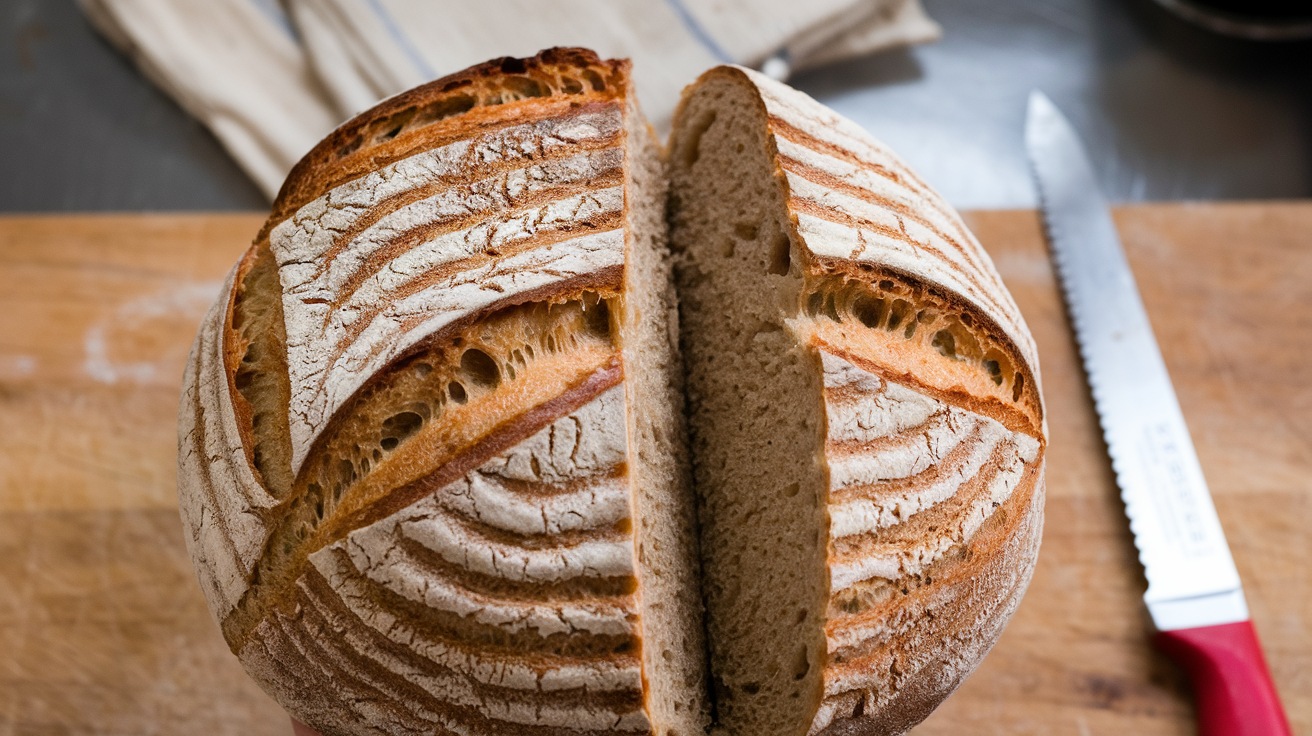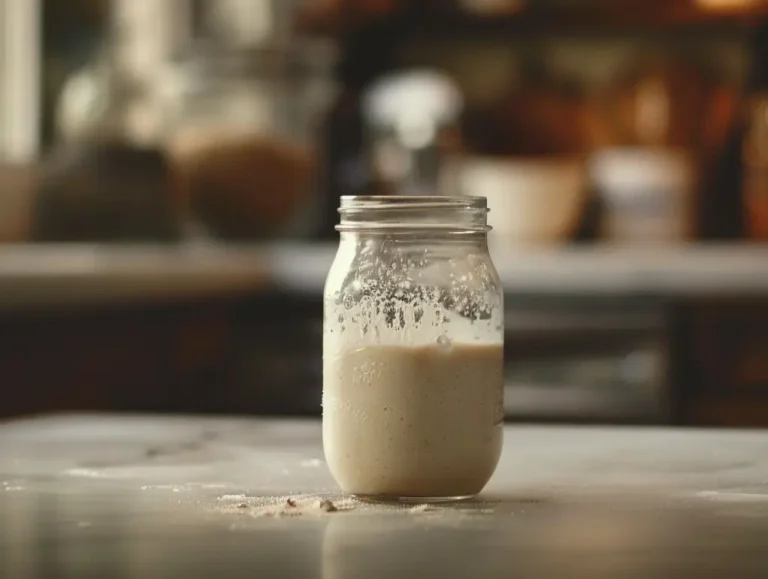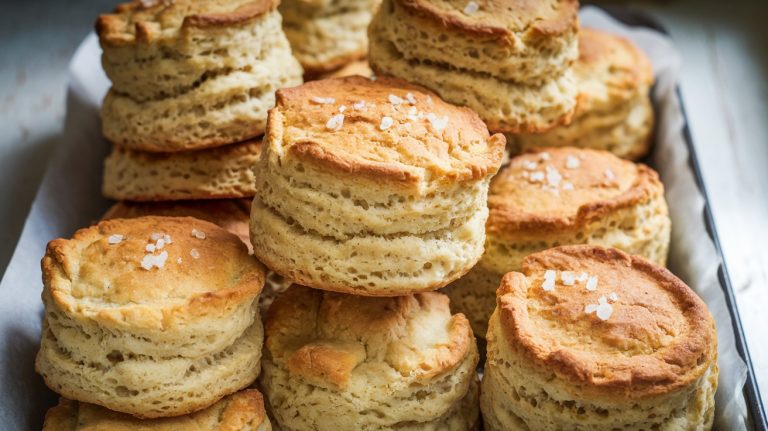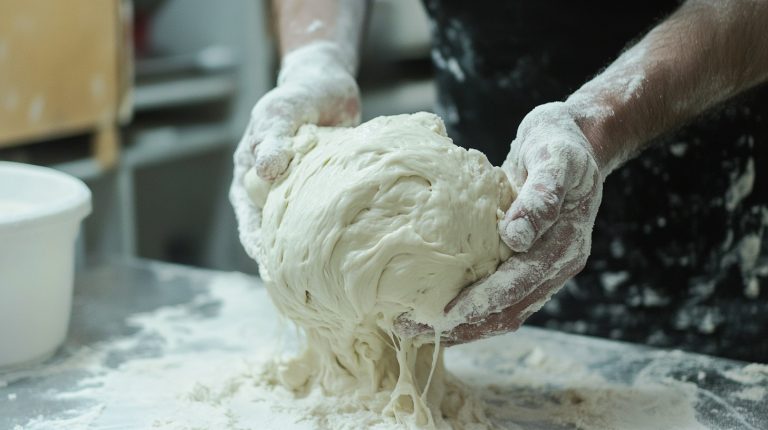Why Is My Sourdough Bread Gummy: Common Mistakes and Fixes
If your sourdough bread is gummy, several factors could be at play. Under fermentation might be preventing proper gas release, leading to a dense crumb.
An immature starter won’t support sufficient fermentation, while poor gluten development struggles to trap gas effectively. Overhydration disrupts gluten formation, causing fogginess.
Additionally, baking conditions like incorrect oven temperature can hinder moisture evaporation, resulting in a gummy loaf.
To combat this, make certain your starter is healthy and mature, allow adequate fermentation and proofing time, and adjust hydration levels. Understanding these elements can help pinpoint the issue and improve your baking results considerably.
Key Takeaways
- Under fermentation can lead to insufficient gas release, resulting in a tight and gummy crumb in sourdough bread.
- An immature starter may fail to provide adequate fermentation support, contributing to poor rise and density in the loaf.
- Weak gluten development hinders gas retention, causing a dense crumb and irregular shape in the final bread.
- Overhydration disrupts gluten formation, leading to a soggy texture and gummy consistency in your sourdough.
- Improper baking conditions, such as incorrect oven temperature and inadequate steam, can prevent proper moisture evaporation, resulting in a gummy loaf.
Common Causes of Gummy Sourdough
Gummy sourdough bread can be a frustrating outcome for any baker, and understanding its common causes is vital to achieving that perfect loaf. One major culprit is under fermentation. If you don’t allow enough bulk fermentation time, the carbohydrates won’t break down fully, preventing gas release. An immature sourdough starter can also hinder proper fermentation, while poor gluten development results in a weak network that can’t hold gas bubbles, leading to a dense, gummy crumb. Additionally, thorough stretch and fold techniques can enhance gluten structure and improve the final loaf.
Overhydration is another issue. Adding too much water to your dough can disrupt gluten formation, while using high-protein flour might cause excessive water absorption. Additionally, inadequate evaporation during baking or insufficient cooling time can leave your bread soggy. It’s essential to monitor room temperature as it can significantly affect fermentation rates.
Don’t overlook your starter’s health. An inactive or underproofed starter won’t rise properly, resulting in uneven texture.
Finally, pay attention to baking conditions. Incorrect oven temperature can impede moisture evaporation, and inadequate steam may lead to an uneven crumb.
Signs You Have Gummy Bread
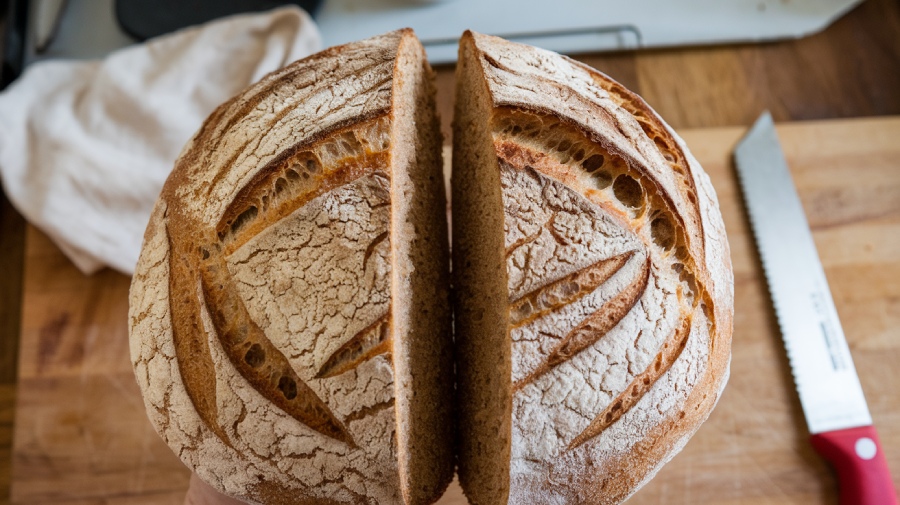
Identifying gummy bread is key to diagnosing issues in your sourdough baking process. You’ll notice several telltale signs that indicate your loaf has gone gummy. Pay attention to the texture, shape, and visual indicators.
| Sign | Description | Emotional Impact |
|---|---|---|
| Tight and gummy crumb | Insufficient CO2 gas development | Frustration over missed expectations |
| Irregular shape | Uneven expansion leads to disappointment | Disappointment in appearance |
| Dense crumb | Indicates poor fermentation | Disheartenment in quality |
| Often associated with under proofing | Often associated with underproofing | Concern over texture |
| Curved edges | Bottom curves upwards, signaling issues | Anxiety about the baking process |
A gummy texture often results from excess moisture and inadequate fermentation. Proper fermentation is crucial for ensuring optimal texture and rise in your bread. You might also find uneven air bubbles or a compact crumb, which signal poor yeast activity. If your loaf lacks that airy, open structure, it’s likely underproofed.
Importance of a Healthy Starter
A healthy starter plays a significant role in achieving the desired texture and flavor in your sourdough bread. It’s important to feed your starter every 12 to 24 hours when kept at room temperature. In warmer environments, aim for every 12 hours; otherwise, you can extend feeding to every 24 hours in cooler conditions. If you store your starter in the fridge, weekly feedings will suffice.
Using an immature starter often results in gummy bread. An underdeveloped starter can’t adequately proof the dough, leading to poor rise and undesirable texture. Before baking, verify your starter has doubled in size and boasts a pleasant aroma. A well-maintained starter not only ensures a reliable rise but also contributes to the development of complex flavors in your bread. The use of all-purpose flour in your starter provides essential nutrients that support yeast and bacteria growth.
Regular maintenance is essential; discard part of the mature starter and refresh it with equal parts flour and water, mixing until you achieve a smooth texture free of clumps.
A healthy starter should be active and bubbly, indicating robust yeast and bacteria presence.
Fermentation Challenges
Understanding the dynamics of fermentation is key to achieving a satisfactory sourdough loaf. One of the most critical aspects is bulk fermentation. If you rush this stage, your dough may not ferment adequately, leading to a gummy crumb.
Make certain you allow sufficient time for the yeasts and bacteria to work their magic on the sugars in your dough. Temperature also plays a significant role—monitor it closely to maintain an ideal fermentation rate. Consider extending the bulk fermentation time or incorporating a cold bulk phase for better results. A longer fermentation may be necessary for adequate dough development. Additionally, maintaining an optimal dough temperature of 74 to 78°F can significantly enhance fermentation performance.
Next, don’t underestimate the importance of proofing. Insufficient proofing can mirror the effects of under-fermentation, contributing to that gummy texture you want to avoid.
Be mindful of your proofing environment, as temperature and humidity can heavily influence your bread’s final quality.
Lastly, evaluate your handling and shaping techniques. Over-manipulating the dough can damage the gluten network, resulting in density issues.
Stretching and folding during bulk fermentation to enhance dough strength and even yeast distribution. Proper shaping techniques are essential for achieving that desired crumb structure.
Effective Solutions for Gummy Sourdough
Gummy sourdough can be frustrating, but several effective solutions can help you achieve that perfect loaf. Start by optimizing your hydration levels; if your dough is too wet, consider reducing the water content to improve texture. Choosing the right flour is crucial, as some varieties, like rye, absorb more moisture; using high-protein flour is essential to support gluten development during fermentation. Additionally, employing techniques like coil folds can enhance gluten strength, particularly in high-hydration doughs.
Next, focus on your baking techniques. Guaranteeing proper proofing is essential—underproofing or overproofing can lead to a gummy texture. Adjusting baking temperature and time can also enhance the crumb. Try extending the baking time at a lower temperature to achieve better results.
Finally, don’t overlook your starter. Make certain it’s active and mature, doubling in size with a pleasant aroma before use.
Here’s a quick reference table to summarize these solutions:
| Solution | Description |
|---|---|
| Adjust Hydration | Reduce water for better texture |
| Improve Proofing | Guarantee proper proofing for gluten structure |
| Optimize Baking Time | Bake longer at a lower temperature |
| Maintain Starter Health | Use a mature starter for effective fermentation |
Frequently Asked Questions
Can the Type of Water Affect Sourdough Texture?
Yes, the type of water you use can greatly affect your sourdough texture.
Soft water, with fewer minerals, can lead to stickier dough and slower gluten development, while hard water strengthens gluten, resulting in a firmer structure.
Additionally, water’s mineral content influences fermentation rates and yeast activity.
How Does the Room Temperature Impact Fermentation?
Imagine your dough as a plant. Just like a plant thrives in the right sunlight, your sourdough flourishes at ideal room temperatures.
If it’s too cold, fermentation slows, stunting growth; if too hot, it races ahead, risking overproofing. Ideally, keep it between 74-80°F.
This balance encourages active yeast and bacteria, cultivating flavor and texture. Use tools like a thermometer to monitor, ensuring your dough develops fully into a delicious loaf.
Should I Use a Specific Type of Flour for Sourdough?
When choosing flour for sourdough, focus on the protein content. Use a flour with 10.5-12.5% protein for ideal results.
High-protein flours can absorb excessive water, leading to dense textures. If you opt for rye or semolina, adjust hydration levels, as these flours retain more moisture.
Pay attention to the flour’s quality and type; the right balance guarantees a light, airy crumb in your sourdough bread.
What Role Does Kneading Play in Preventing Gumminess?
Kneading plays an essential role in developing gluten, which affects your dough’s elasticity and structure.
When you knead properly, you create a balanced gluten network that traps gases during fermentation, contributing to a well-risen loaf.
Avoid over-kneading, as that can lead to a tough texture.
Additionally, make sure your dough remains tacky but not sticky, allowing for better moisture balance, which helps prevent any potential gumminess in your final bread product.
Can Adding Ingredients Like Seeds or Nuts Cause Gumminess?
Adding ingredients like seeds or nuts can indeed cause gumminess in your bread.
In fact, seeds absorb about 1.5 times their weight in water, which can upset your dough’s hydration balance. If you don’t adjust the water content accordingly, you’ll end up with a wet texture.
To prevent this, carefully monitor your seed-to-flour ratio, increase bulk fermentation time, and guarantee adequate baking time to dry out those added ingredients thoroughly.
A Perfect Sourdough: Say Goodbye to Gummy Textures
To avoid gummy sourdough, addressing the root causes, like under-proofing or insufficient hydration is vital. Think of your bread as a delicate dance—each ingredient and technique must perform in harmony.
You can achieve that perfect loaf by nurturing a healthy starter, adjusting fermentation times, and paying attention to hydration levels. Remember, patience and practice are your best allies in this culinary journey, transforming potential gumminess into a beautifully textured bread that sings with flavor.

